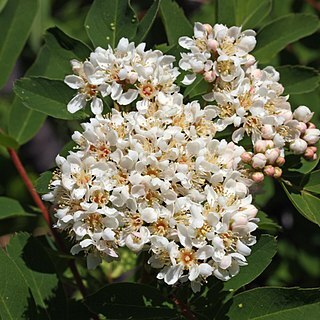Shrubs, 10–40 dm. Stems 1–8; bark initially reddish purple to brownish gray, becoming grayish red; winter buds red-purple to red-brown, conic to ovoid, 8–13 mm, dull, ?slightly glaucous?, not glutinous, sparsely or densely villous, hairs primarily rufous. Leaves pinnately compound; stipules persistent, sometimes deciduous, hairs rufous; blade paler abaxially, dull blue-green, usually slightly glaucous, rarely faintly shiny adaxially, leaflets 7–13, opposite, sometimes subopposite, oblong to narrowly elliptic, sometimes oblanceolate, ovate, or obovate, 1.8–6 × 0.6–2.5 cm, l/w ratio 1.9–3.5, margins entire or finely to coarsely serrate, sometimes doubly serrate, apex obtuse or acute, surfaces soon glabrous, leaf and leaflet axils hairy, hairs rufous. Panicles 12–80-flowered, rounded, 2–8 cm diam.; peduncles glabrous, glaucous, or sparsely to densely villous, hairs primarily rufous. Pedicels glabrous, glaucous, or sparsely to densely villous, hairs primarily rufous. Flowers 11–17 mm diam.; hypanthium glabrous, ?glaucous?, hypanthium plus sepals 3–4 mm; sepals 1–2.2 mm, margins lightly to moderately ciliate, ?hairs rufous or whitish?, infrequently glandular; petals white, rarely pinkish, rhombic to ovate, 4–7.5 mm; stamens 15–20; carpels distinct, apex concave, depressed, or slightly conic and truncate, styles 3–5, 1.5–3.2 mm. Infructescences glabrous, glaucous, or villous. Pomes pinkish red or red (often appearing slightly purplish), subglobose to broadly elliptic or obovoid, 7–13 × 7–13 mm, dull, glaucous; sepals inconspicuous, incurved. Seeds red-brown, ovoid to ovoid-lanceolate, oblong or elliptic, 3.4–5 × 2.2–2.9 mm, symmetric or trigonous, slightly flattened.
More
A shrub or small tree. It grows to 6 m high. The bark is smooth and light grey. The crown is rounded. The leaves are alternate and compound. There are 7-11 leaflets on a red central stalk. This stalk is 8-15 cm long. The leaflets are oval and 2-6 mm long. There are teeth towards the tip. They are dark green above and paler underneath. The fruit are small. They are 6-8 mm across. They occur in erect rounded clusters. The fruit are orange, red or purple. They are 10-12 mm across. They occur in small clusters 5-10 cm across.
Open conifer woods, forest edges, mountain slopes, meadows, shores of lakes and streams, rockslides, edges of avalanche tracks, peatlands, muskegs; mainly on rich, moist soils; at elevations up to 3,000 metres.
More
It is a temperate plant. It reaches the alpine tree line in Canada.
Can be grown by seedlings. Seeds needs stratification.


